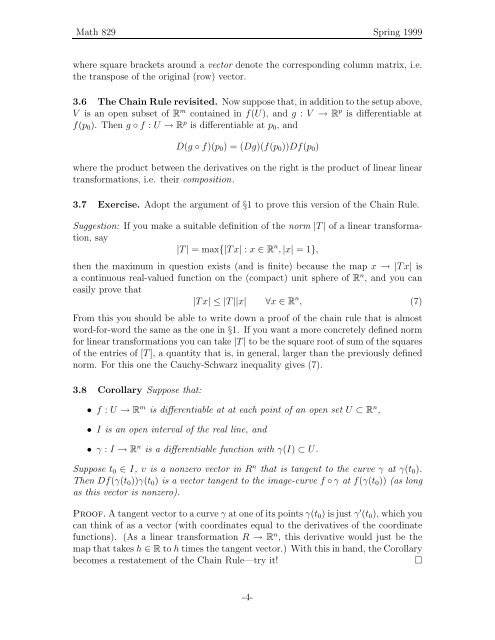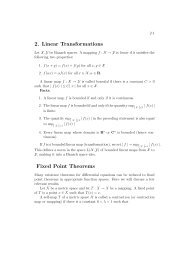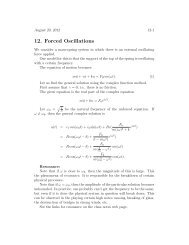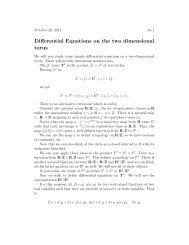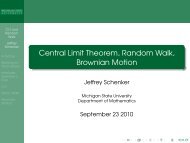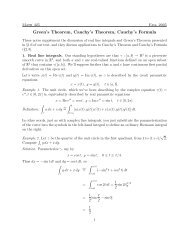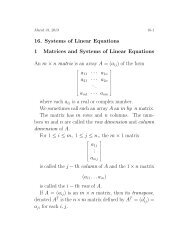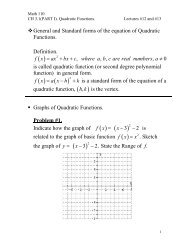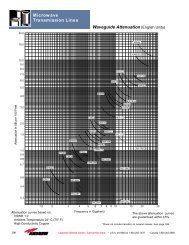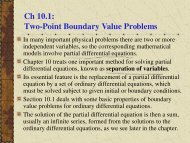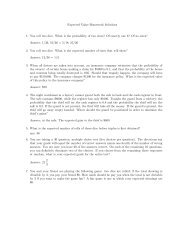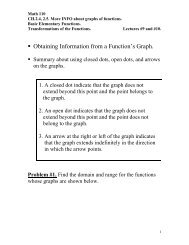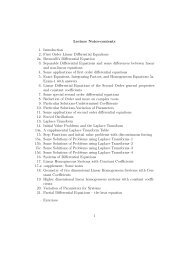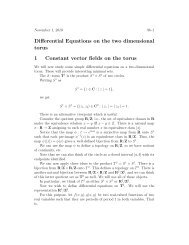Notes on Differentiation - Michigan State University
Notes on Differentiation - Michigan State University
Notes on Differentiation - Michigan State University
You also want an ePaper? Increase the reach of your titles
YUMPU automatically turns print PDFs into web optimized ePapers that Google loves.
Math 829 Spring 1999where square brackets around a vector denote the corresp<strong>on</strong>ding column matrix, i.e.the transpose of the original (row) vector.3.6 The Chain Rule revisited. Now suppose that, in additi<strong>on</strong> to the setup above,V is an open subset of R m c<strong>on</strong>tained in f(U), and g : V → R p is differentiable atf(p 0 ). Then g ◦ f : U → R p is differentiable at p 0 , andD(g ◦ f)(p 0 )=(Dg)(f(p 0 ))Df(p 0 )where the product between the derivatives <strong>on</strong> the right is the product of linear lineartransformati<strong>on</strong>s, i.e. their compositi<strong>on</strong>.3.7 Exercise. Adopt the argument of §1 to prove this versi<strong>on</strong> of the Chain Rule.Suggesti<strong>on</strong>: If you make a suitable definiti<strong>on</strong> of the norm |T | of a linear transformati<strong>on</strong>,say|T | = max{|Tx| : x ∈ R n , |x| =1},then the maximum in questi<strong>on</strong> exists (and is finite) because the map x →|Tx| isa c<strong>on</strong>tinuous real-valued functi<strong>on</strong> <strong>on</strong> the (compact) unit sphere of R n , and you caneasily prove that|Tx|≤|T ||x| ∀x ∈ R n , (7)From this you should be able to write down a proof of the chain rule that is almostword-for-word the same as the <strong>on</strong>e in §1. If you want a more c<strong>on</strong>cretely defined normfor linear transformati<strong>on</strong>s you can take |T | to be the square root of sum of the squaresof the entries of [T ], a quantity that is, in general, larger than the previously definednorm. For this <strong>on</strong>e the Cauchy-Schwarz inequality gives (7).3.8 Corollary Suppose that:• f : U → R m is differentiable at at each point of an open set U ⊂ R n ,• I is an open interval of the real line, and• γ : I → R n is a differentiable functi<strong>on</strong> with γ(I) ⊂ U.Suppose t 0 ∈ I, v is a n<strong>on</strong>zero vector in R n that is tangent to the curve γ at γ(t 0 ).Then Df(γ(t 0 ))γ(t 0 ) is a vector tangent to the image-curve f ◦ γ at f(γ(t 0 )) (as l<strong>on</strong>gas this vector is n<strong>on</strong>zero).Proof. A tangent vector to a curve γ at <strong>on</strong>e of its points γ(t 0 ) is just γ ′ (t 0 ), which youcan think of as a vector (with coordinates equal to the derivatives of the coordinatefuncti<strong>on</strong>s). (As a linear transformati<strong>on</strong> R → R n , this derivative would just be themap that takes h ∈ R to h times the tangent vector.) With this in hand, the Corollarybecomes a restatement of the Chain Rule—try it!□-4-


